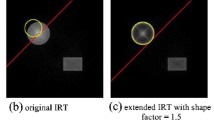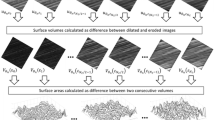Abstract
We have developed a new pattern-recognition algorithm based on multiple intensity clips which assures an optimal adaptation to the solar structure under study. The shapes found at higher clip levels are repeatedly extended to lower levels, thus filling more and more of the observed intensity contours. Additionally, at each intensity threshold new shapes, exceeding the level, are integrated. The number and height of the levels can be optimized making this `multiple level tracking' algorithm (MLT) superior to commonly used Fourier-based recognition techniques (FBR). The capability of MLT is demonstrated by application to the intensity structure of solar granulation near the disk center, both speckle reconstructed and not. Comparisons with Doppler maps prove its reliability. The granular pattern recognized by MLT differs essentially from that obtained with FBR. Elongated `snake-like' granules do not occur with MLT and, consequently, the perimeter-area distribution exhibits only a marginal `second branch' of higher fractal dimension, which dramatically diminishes the better the MLT pattern matches the granular structure. The final distribution obtained with optimized parameters has a single fractal dimension near 1.1, making the question of a `critical size', a `second branch', and the often discussed dimension of 4/3; highly questionable. This result is equally obtained from application of MLT to the corresponding Doppler velocity map of granular up-flows. In contrast, the pattern of down-flows contains some elongated `snake-like' structures with higher fractal dimension. We also use the new algorithm to recognize speckle-reconstructed limb faculae, which MLT separates from their granular surroundings, and compare both, granules and faculae, using large statistical samples. The facular grains near cosθ=57° exhibit a slightly different ellipticity than the (geometrically foreshortened) adjacent granules. However, small facular grains are more round than small granules and larger grains are more similar to granules.
Similar content being viewed by others
References
Balthasar, H., Grosser, H., Schröter, C., and Wiehr, E.: 1990, Astron. Astrophys. 235, 440.
Bovelet, B. and Wittmann, A.: 1999 Publ. Astron. Gesellschaft, Abstract Series 15, 93.
De Boer, C. R., Stellmacher, G., and Wiehr, E.: 1997, Astron. Astrophys. 324, 1179.
Deinzer, W., Hensler, G., Schüssler, M., and Weisshaar, E.: 1984, Astron. Astrophys. 139, 426.
Greimel, R., Brandt, P, Guenther, and E., Mattig, W.: 1990, Vistas Astron. 33, 413.
Hirzberger, J., Vazques, M., Bonet, J. A., Hanslmeier, A., and Sobotka, M.: 1997, Astrophys. J. 480, 406.
Hirzberger, J., Bonet, J. A., Vázques, M., and Hanslmeier, A.: 1999, Astrophys. J. 515, 441.
Knölker, M., Schüssler, M., and Weisshaar, E.: 1988, Astron. Astrophys. 194, 257.
Krieg, J., Kneer, F., Koschinsky, M., and Ritter, C.: 2000, Astron. Astrophys. 360, 1157.
Muller, R.: 1977, Solar Phys. 52, 249.
Muller, R.: 1988, in R. J. Rutten and G. Severino (eds.) Solar and Stellar Granulation, NATO-ASI Series 263, 101.
Muller, R.: 1999, in A. Hanslmeier, M. Meserotti (eds.), Motions in the Solar Atmosphere, ASSL 239, 35.
Nesis, A., Durrant, C. J., and Mattig, W.: 1988 Astron. Astrophys. 201, 153.
Nordlund, A., Spruit, H. C., Ludwig, H.-G., and Trampedach, R.: 1997, Astron. Astrophys. 328, 229.
Roudier, T. and Muller, R.: 1987, Solar Phys. 107, 11.
Schatten, K. H., Mayr, H. G., Omidvar, K., and Maier, E.: 1986, Astrophys. J. 311, 460.
Sütterlin, P., Wiehr, E., and Stellmacher, G.: 1999, Solar Phys. 189, 57.
Title, A. M., Tarbell, T. D., Topka, K. P., Ferguson, S. H., and Shine, R. A: 1989, Astrophys. J. 336, 475.
Wiehr, E. and Kneer, F.: 1988, Astron. Astrophys. 195, 310.
Wittmann, A. D.: 1979, Mitt. Kiepenheuer-Inst. 179, 29.
Author information
Authors and Affiliations
Rights and permissions
About this article
Cite this article
Bovelet, B., Wiehr, E. A New Algorithm for Pattern Recognition and its Application to Granulation and Limb Faculae. Solar Physics 201, 13–26 (2001). https://doi.org/10.1023/A:1010344827952
Issue Date:
DOI: https://doi.org/10.1023/A:1010344827952




